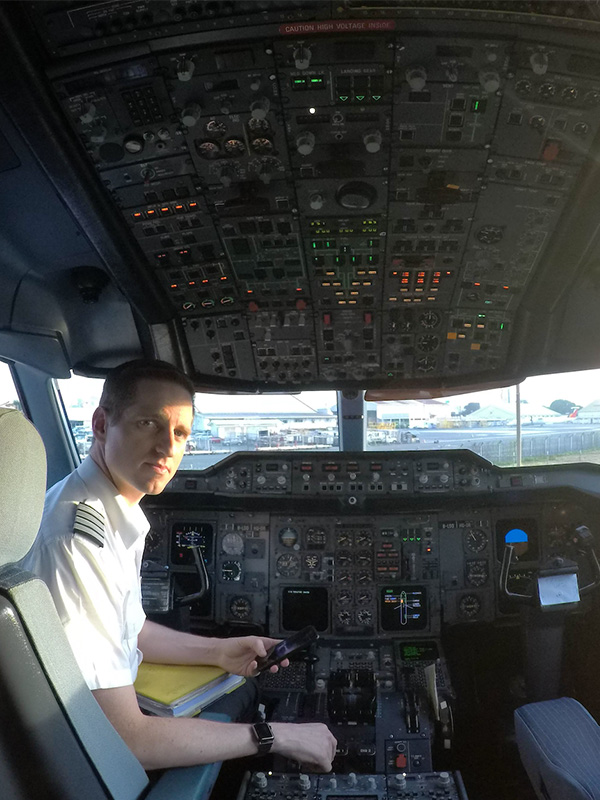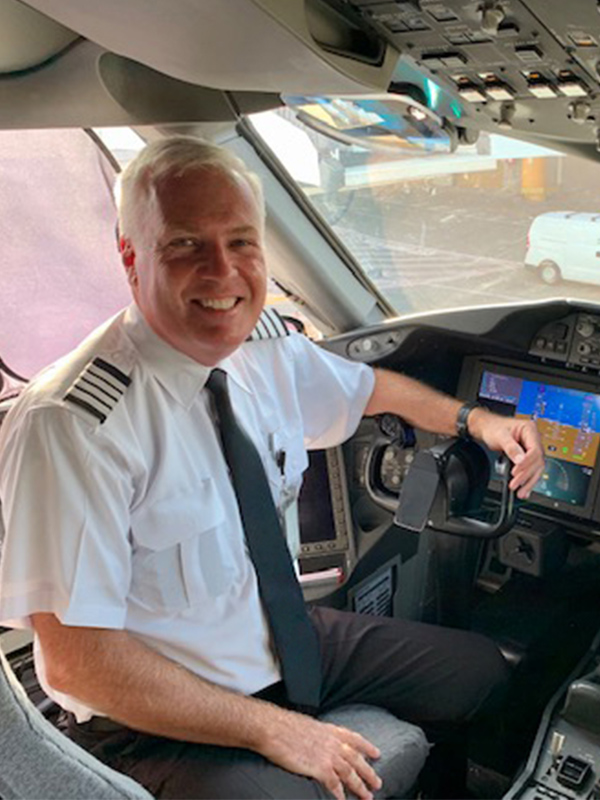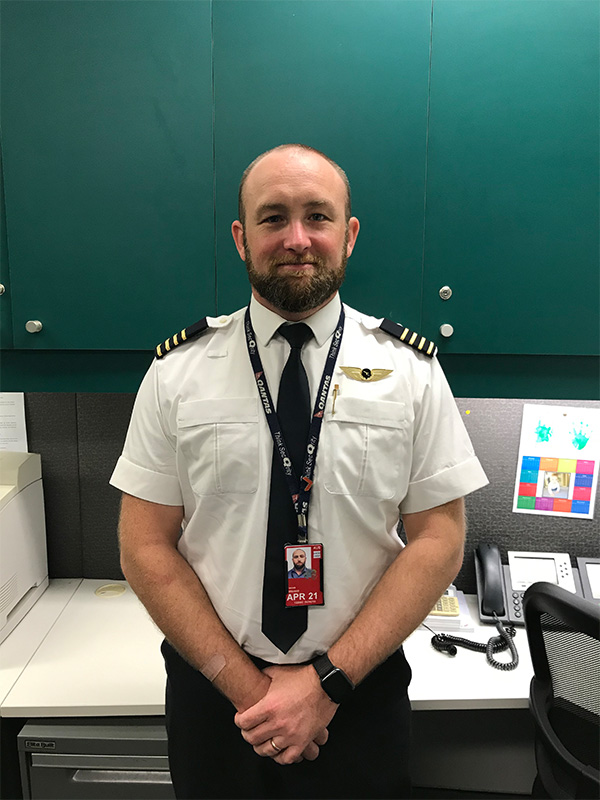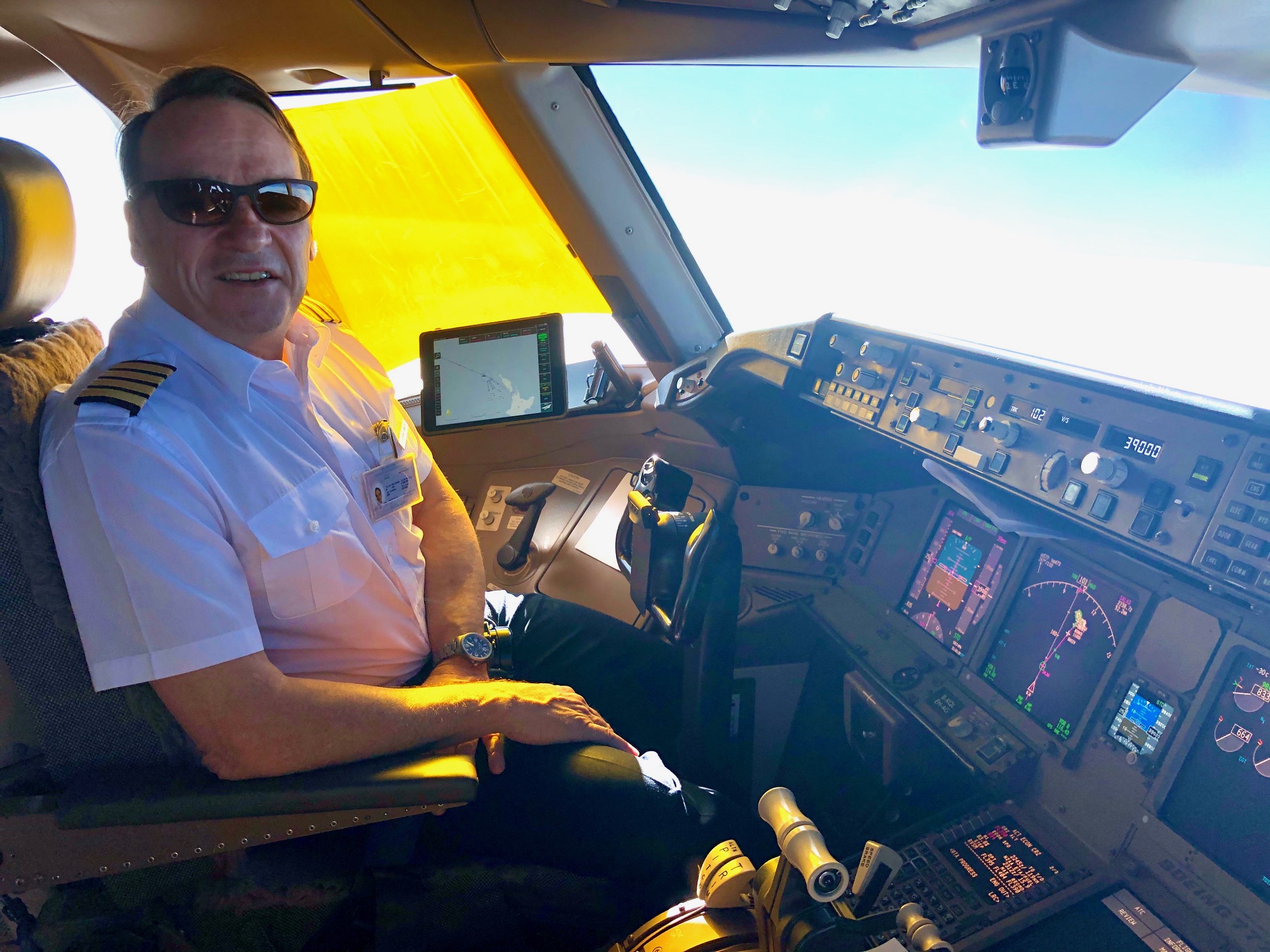

Nelson Catabrigga
Nelson recalls that it’s a strange position to be in when you are licensed to fly an aircraft, but not quite organised enough to drive a car.
He started flying gliders with the RAAF Gliding Club while still at school and completed his CPL/IR and a Bachelor of Aviation in 1998. An instructor rating was Nelson’s first foray into a teaching role which landed him his first job at Bankstown Airport in Sydney.
After a couple of years instructing and general charter work Nelson headed to Africa to build some experience in remote bush flying ops. Most of the runs were into interesting strips dotted throughout Botswana, Zimbabwe, and Namibia in the usual suspects of bush flying – Cessna 206/207/208s.
At the mere age of 24, the offer of attending an airline selection process brought him home and after managing to get through the hurdles he began his airline career on the 747. Over the following years Nelson worked up (& down) through the ranks giving him the opportunity to fly the 767, A380, and now the 787.
Nelson isn’t too proud to admit his mistakes and looks forward to providing guidance to those just entering the industry and those looking to advance their careers alike.

ANDREW SPENCER
Andrew Spencer began his flying career in Perth, Western Australia, just after graduating from High School in 2001. After applying for various airline cadetships, it was evident the events ofSeptember that year had caused the industry to slow recruitment considerably, and the search for alternatives led him to an unexpected path. He enrolled in the Science Aviation stream at Edith Cowan University and once gaining a CPL took advantage of the university’s Shark Patrol flights helping protect summer beach-goers as a means to earn his first commercial flight hours. Andrew then did a Flight Instructor Rating and became a ground theory instructor for China Southern’s training facility in Perth. Teaching CPL theory to cadet’s with a limited grasp of English was a real challenge, but was a great ‘apprenticeship’ towards giving practical flight training in the German-built Grob G115.
He later moved to Singapore Flying College flying C172 and the Beechcraft Baron and was promoted as a Grade 1 Instructor to a supervisory role managing both Syllabus and Competency-based Training. A pathway had existed to the parent airline, SIA, but external factors once again played their part and the 2008 global financial crisis caused recruitment delays for all. He looked for opportunities elsewhere and was fortunate to be offered a position in Hong Kong.
Andrew joined Air Hong Kong (AHK) in February 2011 as a First Officer on the Airbus A300-600R; an older first-generation wide-body aeroplane like the ones he used to watch as a kid flying forAustralian Airlines. He never thought he would get an opportunity to fly, let alone Command one but the highlight of his career (thus far) came later when transferred to the Boeing 747-400 in 2014. This was the childhood dream realised, to fly the original Queen of the Skies. He had the privilege of flying her for three years and never wanted it to end, but a bittersweet move back to the A300 was required when in 2017 he was selected to realise an even bigger dream and become a Captain. And nearly 15 years to the day after obtaining his CPL Andrew gained his 4th bar.

TONY RIKKERS
Tony Rikkers is a freelance aviation professional, providing services to industry around Australia. His career has taken him from an established role in the Aviation Training Industry, to becoming an Independent Flight Examiner, an Aeromedical Pilot and subsequently Corporate Aviation crewing both Domestic and International Flights.
He presently holds a Flight Examiner Rating and conducts Private and Commercial Pilot License tests, Instrument and Instructor Rating tests as well as Aircraft Type Rating Tests and Proficiency Checks in a variety of turbo prop, business jet and flight simulators.
Tony regularly conducts contract flight crewing and is current on Beech 1900, Citation CJ2 and Dassault Falcon 900 aircraft, and is qualified to fly additional Beechcraft, Pilatus, Cessna Citation and Falcon Aircraft when required. At times, Tony will assist operators with short term regulatory requirements, holding positions such as Chief Pilot or Training and Check Pilot.
Based in Perth and holding an Air Operator Certificate and 141 Training Approval operating as Perth Aviation and Advanced Aircraft Training, Tony provides mentoring and training to private aircraft owners, especially those with high performance or turbine aircraft. Tony is a CSIP or Cirrus Standardized Instructor Pilot in support of training for Cirrus Aircraft Owners.
Beyond his aviation pursuits, Tony enjoys travel, keelboat racing and practicing his golf swing.

MARK WHEELER
Mark grew up in Perth in a family that was largely involved in agriculture and first was introduced to aviation at the age of 12 on a cattle station “Wyloo”in the Ashburton area of Western Australia. He was hooked and that was the beginning of what has been a great career for 41 years.
Not having the financial support when he left school, Mark completed an apprenticeship with the Cessna dealer in Western Australia which was owned by Transwest Airlines, becoming Skywest Airlines. During this time he became a LAME, Engines, Airframes and some Turbine engines (PT6 and Allison B17). At night he would attend night school at TAFE and studied up to my Commercial subjects and Instrument rating. On weekends and holiday she would do his flying lessons. By the time he finished his apprenticeship he was 22 yrs old, had just on 1000 hrs and had completed his ATPL subjects. Mark was offered a position as a F/O on the Twin Otter in Kununurra with Skywest and that led to being based in Broome flying the Shrike AC500, Port Hedland on the Cessna 310 and then Perth on the Jetstream J31.
In 1985 Mark completed his entry into Qantas as a Second Officer on the B747 Classic commencing training in Jan 1986.After some 16 months of long haul and missing WA he joined Ansett on commenced on a career that led to flying the Fokker F27, F50, F28, A320 and Kendell CRJ aircraft. Mark was fortunate to get his Command at the age of 28 on the Fokker 50, F28, CRJ and A320. Mark was a Training Captain on all aircraft and a Check Captain on the A320 and CRJ. During his time at Ansett he was seconded to Kendell Airlines to assist with their High Capacity AOC and also introduction of the CRJ to the fleet and became the Training Manager for almost three years, training and ferrying aircraft from Montreal to Melbourne.
Following the collapse of Ansett Mark managed to get a position with EVA on the 744 for 18 months. In 2003 he joined CASA in the Sydney Airline office as the A330 Flight Operations Inspector and during that time offered a position to be the Manager Line Operations A320 for a start up airline being “Jetstar”. Mark has been with Jetstar over 16 years, Chief Pilot for 5 of those years introducing the A320 and A330 aircraft and is currently a Check Captain and Examiner on the B787.

Brett Webber
Brett embarked on a career change after studying a Bachelor of Biomechanical Engineering. Brett began his flying career at the Airline Academy of Australia in Archerfield, Queensland and after a short time in General Aviation, successfully completed an Instructor rating and secured employment with the Australian Wings Academy on the Gold Coast.
After a few years Brett was offered the opportunity to join an Australian based executive jet company and was fortunate enough to spend a few years conducting both International and domestic aeromedical retrieval flights throughout the Pacific and South East Asia.
Due to family commitments, Brett moved into domestic night freight operations and after starting as a Metroliner Captain, moved through the ranks taking on additional Fleet Manager, Training and Check Captain roles culminating in acquiring the position of Head of Flight Operations and Chief Pilot.
Brett is now currently employed with Alliance airlines as a Fokker 50 Turbo-prop Captain and Senior Base Pilot, conducting FIFO Charter operations for the resource sector.
Brett is actively involved in his community and in his early years was a commissioned officer in the Australian Army Reserve and was posted as an Armoured Corps Reconnaissance Troop Leader with the 2nd/14th Light Horse Regiment, Queensland Mounted Infantry. Brett is a currently a volunteer firefighter and Road Crash Rescue member in the South Australian Country Fire Service (CFS).

Jeff Foote

CLIFF BEDSER
Cliff’s aviation career spans 43 years! Beginning as a certified aircraft maintenance engineer with Air Gold Coast at Coolangatta Airport, Cliff then founded ‘Gold Coast Aircraft Sales’ and for 20 years specialised in General Aviation aircraft importing, acquisitions and sales.
Cliff currently fly’s the A380 Airbus for Qantas, holding an ATPL CASA and FAA licence with endorsements on most Boeing and Airbus types. He remains active in General Aviation and RA AUS flying and really is the fountain of knowledge when it comes to the Australian aviation market.

Manan Kinariwala
With his passion for aviation and a keen eye to explore the unseen, Manan stepped in the field of aviation as a student pilot at FTA Brisbane, Australia in May 2007. After numerous challenges he was awarded Australian commercial pilot license in 2011. Due to market downfall in the region and unable to score his first pilot job in Australia and India, he decided to try his luck in the continent of Africa and began to travel around Namibia and Botswana and explore the unexplored part of the world. After 6 months of door knocking he was offered a bush flying job in wilderness of Africa on Cessna 210 & Cessna 310 aircraft. Manan remains to this day to be the only Indian National who holds a current Namibian ATPL. Manan advanced his qualifications and career by moving to Angola and accepting a job on a Beechcraft 1900 D turbine flying for a large oil and gas organisation. Unfortunately this position was short lived due to the operating environment and after spending 4months back at home, Manan decided to pack his bags and try his luck in Island nation of Maldives where he was quickly recruited by Trans Maldivian airways on DHC6 200/300/400 TwinOtter seaplanes. Finally in 2016 Manan landed his dream job on Airbus A320 aircraft inVietnam.With15 aircrafts on his license and boasting experience across a diverse range of operations, Mananis keen to help younger generation achieve their dreams and enjoy a successful career path.

James Graham
James began flying when he was 15, having studied aviation-specific subjects since beginning high school at age 12. He went on to complete a Bachelor of Science (Aviation) at Edith Cowan University in WA, in ‘99. James gained his CPL and MECIR shortly after in 2000, and gained seasonal employment in the NE corner of WA flying C182, C206, C207, and C210 aircraft around the Bungle Bungles.
James then decided to get back into flying with an instructor rating, where he found his passion. Between 2003 and 2007 he worked at Jandakot airport and became a Grade 1 instructor with multi-engine, aerobatics, spin and tailwheel training approval, flying everything from Cessna 150s to Barons, including the Diamond DA20 and DA40.
In 2007 James joined QantasLINK as a Dash 8 First Officer where he became a Captain after one year, a Training Captain after another year, then a Check Captain two years later again. Since 2015 he has been a simulator check captain, running the company simulator assessments for line pilots, and writing those assessments since 2018. James is now one of 4 Senior Examiners in QLink, a qualified Flight Examiner and the Deputy Flight Standards Manager. In that role, James assists in monitoring the standards of all training and checking activities for QantasLINK Flight Crew.

Gordon Ramsay
Gordon became found his flying while travelling around Asia as a child in the 60’s and 70’s with his parents who were based in Singapore and Bangkok. Viscounts, Electras, 707s, HS748s, Bristol Freighters -couldn’t wait to get onboard what ever was going, the now banned inflight cockpit visits added fuel to the fire.
After returning to Australia, Gordon did CPL NAV and Flight Planning whilst still in Year 12 and then a CPL straight out of school. He wrote to all 150 holders of a Charter licence looking for a job. In 1980 GA was in recession (again!). Three replied and only one offered an interview in far off Katherine, NT. Well, the saying at the time was “head north young man!”. He got the job flying a C206 at age 18, paid of his training debts and has never looked back.
Airlines weren’t recruiting (again!), so five fun years and 4000h in the NT and surrounds proved a superb foundation, flying every Cessna from the 182 to the Citation II. Without GPS in those days, navigation from a WAC chart was critical. Looking for a mining strip 550nm north west of Alice from FL350 in a Conquest II using just a WAC chart was interesting.
Eventually airlines started hiring again and it was off to Melbourne to join TAA on the DC-9 then the 737-300. Itchy feet for Asia meant taking a job in Hong Kong in 1988. He has been there ever since (when not in Northern NSW), over the years flying the 747-2/3/400, the A330/340/346 and currently the 777 including being a training Captain on most of these types helping to guide the next generation on their career paths.
Gordon still has a love for GA and believes GA flying and the skills acquired from it are a fundamental foundation for success in many areas of aviation.

Scott Titmarsh
Scott has been flying since 2004 in a variety of roles including general aviation instruction at all levels, IFR charter into remote areas of Australia and multi-crew airline operations as a First Officer and Captain. Scott has amassed over 4000 hours on the A320 family, 2500 of those in command. He has operated over 1700 international flights in 11 countries and welcomes the opportunity to provide assistance and advice to those aspiring to work in South-East Asia.

ALEX RUSSO
Alex began his flying career at the age of 16 in Ingham, North Queensland. He developed a passion for flying after years of watching crop dusters spray the family sugar cane farm. After completing high school in 1987 and continuing to work on his father’s farm, Alex gained his Commercial Pilot’s Licence in 1989. His first job was as a station pilot for Stanbroke Pastoral Company in Western Queensland. He later went on to complete his Instructor rating with FTA in Archerfield and then worked as a Flight Instructor at the Rockhampton aero club and later with China Southern Flying College in Jandakot, Western Australia, where he advanced to be a Senior Instructor with a Grade One instructors rating with Multi engine training approval.
Alex then moved back to Queensland and commenced work with Whitaker Air Charter as a Captain on the Twin Otter and Nomad, where he operated RPT services to Lady Elliot and Great Keppel Islands from Hervey Bay and Rockhampton. Alex’s experience on the Twin Otter took him to Cairns where he worked for Macair Airlines as a Training Captain, this time flying RPT services to Dunk, Lizard and Brampton Islands. After several years, Alex returned to South East Queensland to fly for Sunshine Express Airlines as a Training Captain on the Metro 23 and EMB 110.
In 2004, Alex’s first turbojet position was with Air Vanuatu, based in Port Vila, flying the Boeing 737-300 Classic. In this role, Alex operated as a First officer and flew to several countries in the South pacific including Fiji, Noumea, Solomon Islands and New Zealand.
In 2008, it was time to come home and Alex commenced work with Virgin Australia as a First Officer on the Boeing 737NG. After a year in this role, an opportunity to fly the B777 with Virgin International arose and with his previous international experience, he was selected as a Senior First Officer. Alex flew to Los Angeles, Johannesburg, Abu Dhabi, Kuala Lumpa, and Phuket over a period of 11 and a half years. During his time on the B777, Alex once again became involved in a training role. Responsibilities as a trainer included that of Simulator Instructor and Type Rating Instructor on the Boeing 777. Alex also held approvals to conduct Simulator Instructor Training and Line Proficiency Assessments.
Due to the COVID 19 pandemic, Alex completed several repatriation flights worldwide, and included one of the longest recorded flights on a 777. This necessitated flying non-stop from Paris to Brisbane, at an eye watering 19 hrs and 43 minutes flight time!
Alex has recently renewed his Grade One Instructor rating and is excited to share his wealth of knowledge and experience with a new generation of aviators.

Cornay Sinac
For Cornay, like many kids of his generation, a visit to the cockpit started off the journey to becoming a pilot. A secretive group of uniformed professionals working in a complicated moving office was mesmerising to the 10 year old.
Cornay was extremely fortunate that his father recognised the spark and at the age of 16 took his to Moorabbin airport near Melbourne where he took a trial flight to see if it would develop into a fire. It did. There was an unspoken promise between the two of them: do your best AND never give up. He subsequently went on to achieve what was then known as a Restricted Private Pilot Licence. Then after completing the navigation sequences, was granted a Private Pilot Licence at the age of 17. Cornay gave flying a 12 month hiatus whilst completing his HSC. Commercial Pilot Licence (CPL) theory was followed by Airline Transport Pilot Licence (ATPL) theory at Moorabbin; once passed, his CPL flight training began.
After passing the CPL test he came to a crossroad; a flight instructor rating (FIR) or hit the road looking for a job with a bare CPL. This was 1981 and similar to today’s environment, the chances of a job with a bare CPL were slim, so he went on to complete his instructor training. A month later he was offered a position as a grade 3 instructor. So accelerate three years and with a grade 1 FIR, multi engine rating , instrument rating and 2000 hours all he wanted was an airline job so he could join that secretive group of uniformed professionals that he remembered as a kid. Cornay left the instructor world for a very brief stint in Papua New Guinea where he learned the difference between good and bad maintenance practices. He was then employed by a charter organisation flying Piper Navajo (8-10 seat twins) back at Moorabbin and stayed there until on 22nd November 1985 when he was tapped on the shoulder by a large international airline based in Sydney.
If you managed to pass the rigid examinations, promotion was meteoric with the airline’s massive expansion, so starting as a second officer at 24 years old he moved through the ranks to find himself Captain of a Boeing 767 travelling from Mumbai to Tokyo to Vancouver at the age of 34. He was offered a position as training Captain on the B767 and returned to his original first job as instructor. Later he moved to the B747-400 and was asked to be a Senior Check Captain (SCC) – the difference being he would be training pilots not just in the aeroplane, but in the flight simulator as well. Cornay has since moved onto the Airbus A380 fleet as a Type Rating Examiner (the old SCC under a different name).
The call back to General Aviation has always been strong for him but due to family commitments he’s never found the time. However, as his family has grown up, over the last three years between work duties he has managed to reacquaint himself with the world where all this began.
Along his journey within the airline he was guided by some experienced mentors that asked questions, provoked thought and gave inspiration when he was becoming comfortable in his zone. Cornay wished he had this when he was in General Aviation, but the mentors were not there. In some small way he’s hopeful he may be able to redress that situation with the next generation of pilots.
